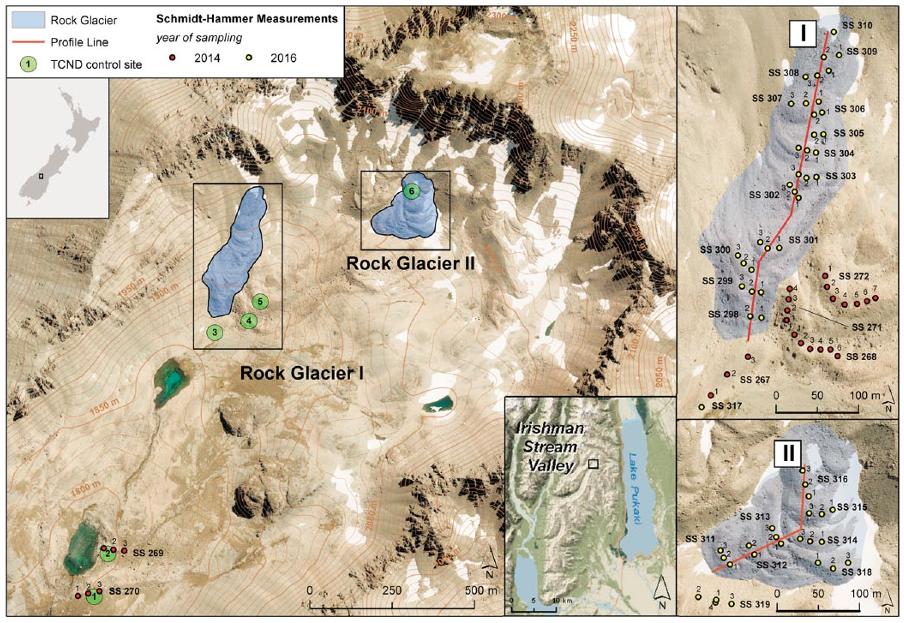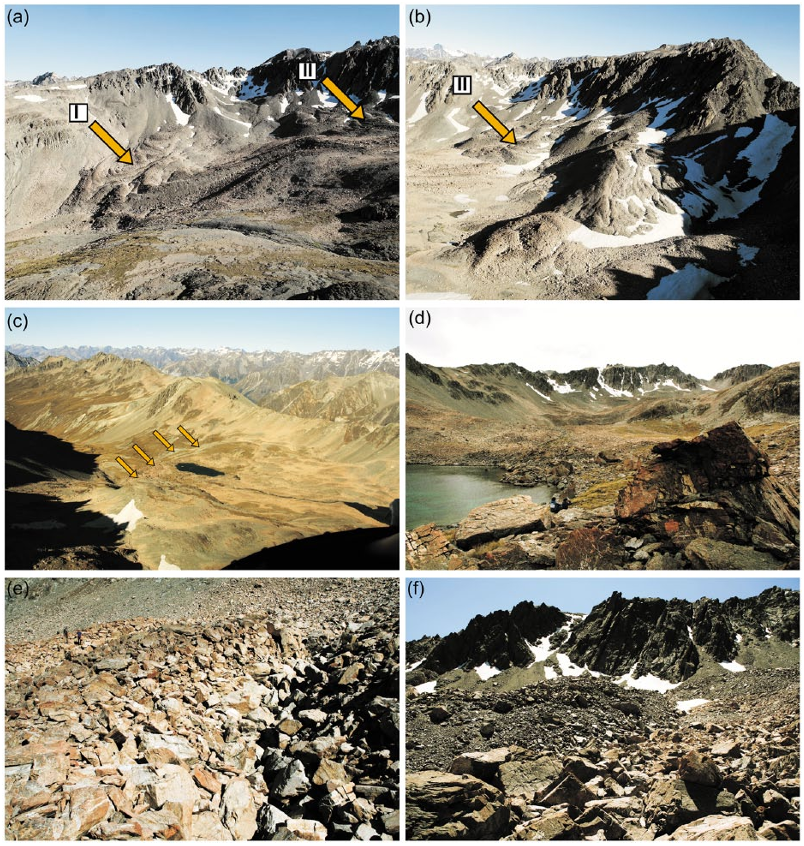




Did you find this useful? Give us your feedback














124 citations
86 citations
69 citations
...Located in Mount Cook National Park (New Zealand), it comprises about 450 ha and is characterized by a sequence of lateral and latero-frontal moraines formed 125–3370 290 years ago (Winkler and Lambiel 2018)....
[...]
22 citations
...This is, moreover, not a trivial task as by contrast to quite detailed information on the horizontal ice sheet margins during the Late Glacial (Hughes et al. 2016), there is still relatively less knowledge about the exact mechanism and local timing of deglaciation within the mountainous parts of central Southern Norway (Dahl et al. 1997; Matthews and Winkler 2011)....
[...]
...In concert with McColl (2012) and Pánek et al. (2016), we consider our RSFs to have occurred during warm phases in the Holocene and the Late Glacial, namely the HTM and the Bølling-Allerød interstadial....
[...]
...This has recently been further improved by the introduction of an electronic version of the Schmidt hammer (Winkler and Matthews 2014) that already has been successfully applied on sorted stone circles (Winkler et al. 2016) and rock glaciers (Winkler and Lambiel 2018)....
[...]
...Furthermore, Tomkins et al. (2016, 2018) show the R-value–age relationship to be linear during the transition from arctic to more temperate conditions (post-LGM to Late Glacial)....
[...]
...…(Table 1), (3) the non-polymodal distribution suggesting no major post-depositional disturbance or polygenetic origin and (4) the established linear weathering relationship during the Holocene and into the Late Glacial (Matthews and Owen 2010; Matthews and Wilson 2015; Winkler and Lambiel 2018)....
[...]
22 citations
713 citations
..., 2013) reflects hemispheric climate patterns (Wanner et al., 2011)....
[...]
...In many northern hemispheric regions, rock glacier initiation following the mid-Holocene Thermal Optimum and even as late as during the ‘Little Ice Age’ (LIA) (Janke et al., 2013) reflects hemispheric climate patterns (Wanner et al., 2011)....
[...]
427 citations
...Their genesis has been largely discussed and two main modes of rock glacier formation have been proposed (Barsch, 1988, 1996; Clark et al., 1998; Haeberli et al., 2006; Humlum, 1988; Whalley and Martin, 1992): (1) periglacial rock glaciers resulting from the creep of ice-rich sediments in…...
[...]
...Their genesis has been largely discussed and two main modes of rock glacier formation have been proposed (Barsch, 1988, 1996; Clark et al., 1998; Haeberli et al., 2006; Humlum, 1988; Whalley and Martin, 1992): (1) periglacial rock glaciers resulting from the creep of ice-rich sediments in permafrost conditions and (2) glacigenic rock glaciers deriving from the burial of small glaciers, mainly located in continental areas....
[...]
372 citations
...Irishman Stream is located east of the 2000 mm isohyet (Sattler, 2016; Tait et al., 2006)....
[...]
315 citations
308 citations
...The timing of major Holocene glacier advances during the late-Holocene pre-dating the ‘LIA’ (Schaefer et al., 2009; Solomina et al., 2015; Winkler, 2014) coincides with increasing intensity of westerly airflow over New Zealand (Turney et al., 2017) and could give evidence that in addition to air…...
[...]
...The two uppermost moraines that likely correlate to similar features in Irishman Stream valley head have not been investigated and could represent the local ‘LIA’ or late-Holocene ‘LIA’-type events as their morphology appears quite ‘fresh’....
[...]
...The timing of major Holocene glacier advances during the late-Holocene pre-dating the ‘LIA’ (Schaefer et al., 2009; Solomina et al., 2015; Winkler, 2014) coincides with increasing intensity of westerly airflow over New Zealand (Turney et al., 2017) and could give evidence that in addition to air temperatures, also atmospheric circulation patterns and precipitation need to be considered as important drivers of glacier fluctuations in the Southern Alps....
[...]
...In many northern hemispheric regions, rock glacier initiation following the mid-Holocene Thermal Optimum and even as late as during the ‘Little Ice Age’ (LIA) (Janke et al., 2013) reflects hemispheric climate patterns (Wanner et al., 2011)....
[...]
...These R-values are similar to those of lateHolocene/‘LIA’ moraines in glacier forelands in Aoraki/Mt Cook (Winkler and Corbett, 2014) especially if a slightly different lithology (occurrence of harder semi-schist together with typical ‘greywacke’) is considered....
[...]
Future work exploring the palaeoclimatic potential of rock glacier in the Southern Alps to establish consolidated regional patterns seems, therefore, of high priority.
the most important outcome of Schmidthammer sampling along the longitudinal profiles is a remarkable, consistent trend of increasing R-values means from the lowermost to the uppermost surface ridges on both rock glaciers.
If air temperatures are the most important drivers of glacier variability in the Southern Alps as claimed by Anderson and Mackintosh (2006) or Mackintosh et al. (2017), one would expect moraine sequences representing shortterm fluctuations during a constant decrease of glacier expansions and activity from the old early Holocene towards the ‘LIA’.
The high annual precipitation likely exceeds 10,000 mm on western slopes and, thanks to an ‘overspill’ effect, is also typical for the Main Divide of the Southern Alps itself and areas immediately to its east (Chater and Sturman, 1998; Griffiths and McSaveney, 1983; Henderson and Thompson, 1999).
retracted early-Holocene glaciers could provide a palaeoclimatic signal for climatic conditions too dry for glaciers, thus questioning the postulated strong dependency on temperature conditions only.
Dating methods applied (see Haeberli et al. (2003) for a review) involve relative-age dating methods such as, for example, the Schmidt-hammer (Kellerer-Pirklbauer et al., 2008; Scapozza et al., 2014) or weathering-rind thickness (Frauenfelder et al., 2005); numerical age-dating methods (radiocarbon dating: Haeberli et al., 1999; terrestrial cosmogenic nuclide dating (TCND): Böhlert et al., 2011a; Cossart et al., 2010a; optical stimulated luminescence: Fuchs et al., 2013); or age estimations based on current velocity fields measured with aerial photogrammetry (Frauenfelder et al., 2005).
If confirmed at other sites across the Southern Alps, rock glacier formation during the first part of the early Holocene also bears potential implications for the regional glacier history.
Their study shows that SHD using an electronic Schmidt-hammer (SilverSchmidt) can successfully be applied for the dating of rock glaciers in the Southern Alps of New Zealand and is efficient with obtaining large sets of raw data.
Their development and evolution is highly sensitive to climatic parameters (Brazier et al., 1998; Humlum, 1998; Kääb et al., 2007); rock glaciers constitute thus an important potential as archive for the regional Late Glacial and Holocene palaeoclimatology.
To avoid potential influence of micro-climatic and micro-weathering differences, furrows on the rock glacier surface between those ridges were avoided (except for one test site).
The primary aim of their study is to test whether SHD can successfully be applied on rock glaciers in the Southern Alps and to compare the results obtained with those of similar studies on rock glaciers elsewhere.
But the model of a regional oscillating glacier retreat from Late Glacial until c. 6500 years ago (Putnam et al., 2012) cannot be supported on the basis of their results of high SHD age estimates of the lowermost rock glacier ridges and because of the excluding nature of rock glaciers and major glacier activity.
It confirms the importance of their consistent sampling design to investigate surface ridges only and, furthermore, improves the reliability of the SHD calibration curve because the sampled fixed points/